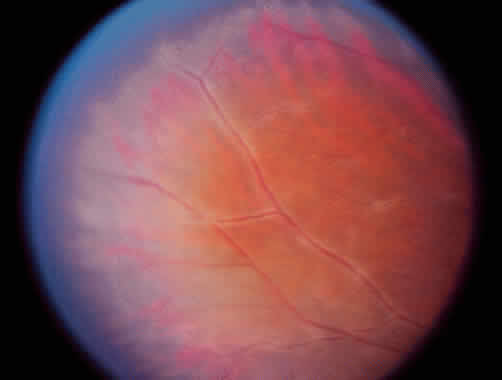#MSBlog: Uveitis or inflammation in the eye is common in MS; don't ignore unusual eye symptoms.
Thouvenot et al. Ipsilateral uveitis and optic neuritis in multiple sclerosis.Mult Scler Int. 2012;2012:372361. doi: 10.1155/2012/372361
Background: Uveitis is 20 times more frequent in MSers than in the general population.
"Uveitis is the medical term we use to describe inflammation of the middle or internal layers of the eye. The symptoms of uveitis vary depending on if the inflammation involves the anterior or front of the eye or the posterior or back of the eye. Common symptoms include, redness of the eye, blurred vision, sensitivity to light or photophobia, floating spots in the visual field, eye pain, floaters, headaches, injected conjunctiva. When we look in the eyes we often see dilated blood vessels, presence of cells in the eye, and precipitates on the surface of the cornea. If the inflammation is severe there may be evidence of a hypopyon or a layer of pus in the eye (see picture below). Inflammation at the back of the eye generally does not have any of these typical symptoms and is more difficult to assess."
Thouvenot et al. Ipsilateral uveitis and optic neuritis in multiple sclerosis.Mult Scler Int. 2012;2012:372361. doi: 10.1155/2012/372361
Background: Uveitis is 20 times more frequent in MSers than in the general population.
Methods: A retrospective study of local MS (n = 700) and uveitis cohorts (n = 450) described the ophthalmological and neurological characteristics of peoplewith multiple sclerosis and uveitis.
Results: Uveitis and multiple sclerosis were associated in seven people. The time intervals between diagnoses of MS and uveitis ranged from 6 months to 15 years. Analysis of the characteristics revealed that MS was associated with an older age of onset than usually expected, that is, 39 years. Uveitis was bilateral in three cases and mainly posterior (5/10). Five MSers presented with acute optic neuritis (two in one eye and three in both eyes). All eyes presenting with acute optic neuritis were also affected by uveitis (P = 0.02), though not simultaneously.
Conclusion: The ipsilateral association between optic neuritis and uveitis in this series of MSers may suggest a reciprocal potentiation between optic neuritis and uveitis in MS.
"Uveitis is a common condition and has many causes. In the context of MS it is considered an autoimmune disease. Up to 30% of MSers get uveitis and therefore it is sensible for an ophthalmologist to assess MSers with visual symptoms to exclude uveitis. Another associated disease which is classified as being uveitis is posterior venulitis, when you see inflammation around the veins in the retinae. This inflammation is considered to be the same inflammation we see around veins in other MS lesions. The big difference is the eye or retina does not normally have any myelin. This implies that the inflammation cannot be in response to myelin, but some other antigen. This is another nugget of gold that challenges the dogma that MS is an autoimmune disease targeting myelin."
"Uveitis is a common condition and has many causes. In the context of MS it is considered an autoimmune disease. Up to 30% of MSers get uveitis and therefore it is sensible for an ophthalmologist to assess MSers with visual symptoms to exclude uveitis. Another associated disease which is classified as being uveitis is posterior venulitis, when you see inflammation around the veins in the retinae. This inflammation is considered to be the same inflammation we see around veins in other MS lesions. The big difference is the eye or retina does not normally have any myelin. This implies that the inflammation cannot be in response to myelin, but some other antigen. This is another nugget of gold that challenges the dogma that MS is an autoimmune disease targeting myelin."
 |
| The white sheathing around the blood vessels of the retinae is called retinal vasculitis and is occurs in up to a third of MSers. This is telling us that what ever is driving inflammation in MS may also be present in the layer of the retinae. It is not myelin and the nerve fibres in the retina don't have myelin. Interesting? |
"Does this post have any implications for you? Possibly, symptoms of uveitis are often missed diagnosed in MSers as being due to optic neuritis. If you have any symptoms suggestive of uveitis please bring these to the attention of your neurologist or nurse. The treatment of uveitis is in general different to that of MS."

0 comments:
Post a Comment